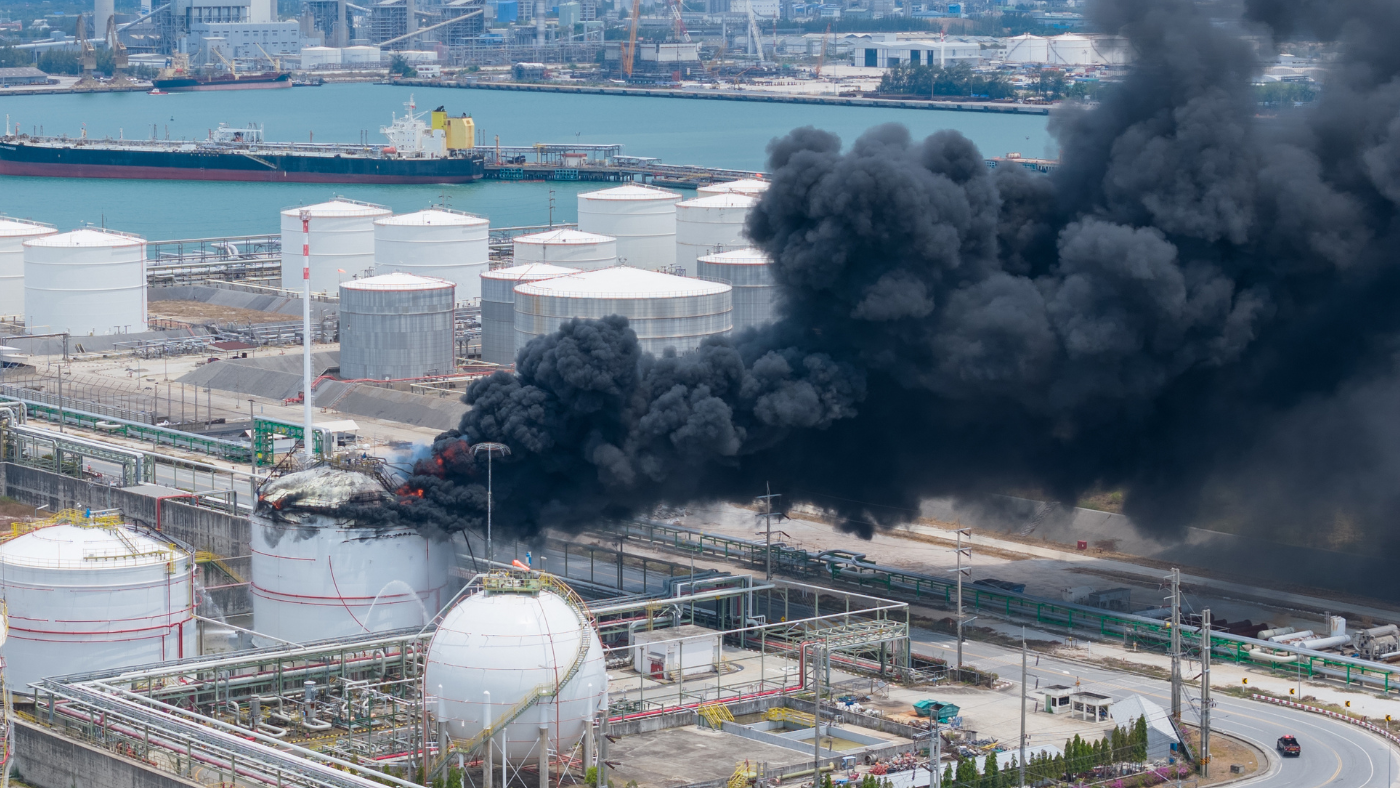When discussing fire protection, commercial or residential fire protection systems are what most often come to mind. These include active protection features encompassing automatic fire sprinklers, manual pull stations, smoke detectors, and horns and strobes, as well as passive features including firewalls, structural fireproofing, compartmentalization, separation, and spill containment. In addition to these systems there is a similar, but very different set of protections that are necessary to provide adequate fire protection in industrial settings.
Common Industrial Locations
Most industrial facilities require fire protection systems. These locations can include food processing facilities, wood mills, alcohol distilleries, refineries, chemical storage facilities, and chemical processing facilities. These types of facilities are often processing, creating, or storing large quantities of products that are flammable, which may include liquids or even dusts; many of which produce large, high intensity fires that are very difficult to suppress with traditional fire protection equipment. Although many of the interior locations are typically equipped with traditional fire protection systems, such as fire sprinklers and fire alarms, they may also require less common fire protection features such as firewater storage tanks, fire pumps, firewater monitors, flammable gas monitoring, toxic gas monitoring, flame detection, explosion detection, or deluge water spray systems.
Industrial Fire and Explosion Detection Methods
Industrial sites will often have a combination of unique fire or gas detectors based on the process involved. Where combustible gases are present, a combustible gas detector, shown in Figure 1 below, would be installed. These sensors monitor the air surrounding the detector and alarm and pre-determined alarm thresholds; the alarms are activated at a main control area and can activate site wide horns and beacons and/or result in executive actions such as emergency shutdown. Gases commonly monitored include combustible gases such as methane, butane, propane, and ethylene, as well as toxic gases such as ammonia, hydrogen sulfide, or chlorine. In addition to point type gas detectors, shown in Figure 1, open path gas detectors can also be used. Open path gas detectors use a beam of light, which may be visible or invisible to the human eye depending on the manufacturer, to view wavelength changes created by the presence of specific gases. Each open path gas detector is constructed and programmed to observe for specific chemicals that may be on site.
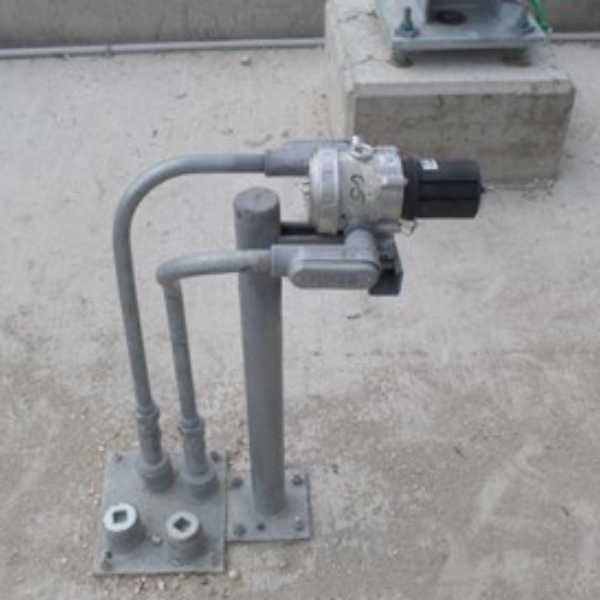
Figure 1: Combustible Gas Detector
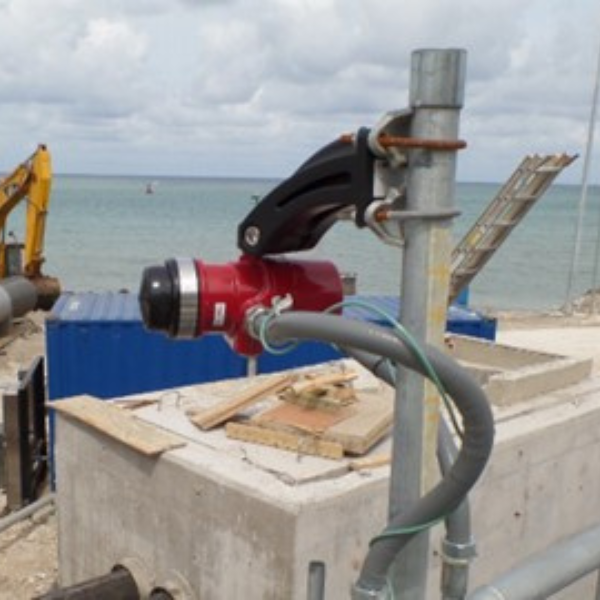
Figure 2: Flame Detector
In addition to gas detectors, there are also various types of flame detectors, an example of which is shown in Figure 2. These flame detectors have optical sensors that monitor for light sources and light frequencies that are associated with flames. Upon detection of a flame signature, the detector will initiate an alarm and activate site wide horns and beacons at most sites. Flame detectors are often chosen for a detection area because they can cover a large area with a single detector; however, that viewing distance must be completely unobstructed. These types of detectors can also detect and alarm a fire condition within milliseconds, which can be critical for sites that are sensing for explosions. The shortcomings for flame detectors are that they must have a clear line of site to the protected area, which can even be obscured by smoke from a sooty fire such as a fire associated with plastic materials.
Industrial Suppression Methods
Due to the potential size and associated damage of a large-scale fire on an industrial site, a domestic water supply is often not adequate for suppression, and these large hazards often require independent firewater storage and distribution systems. These systems can be supplied from a large firewater storage tank or could potentially even draft water from the ocean when in a coastal location, as shown in Figure 3. Regardless of where the water is supplied from, the sites must have pumps used to supply the firewater to the piping network that will distribute water throughout the facility. The firewater pumps can be supplied by diesel driven engine, an electrical motor, and even steam powered turbines.
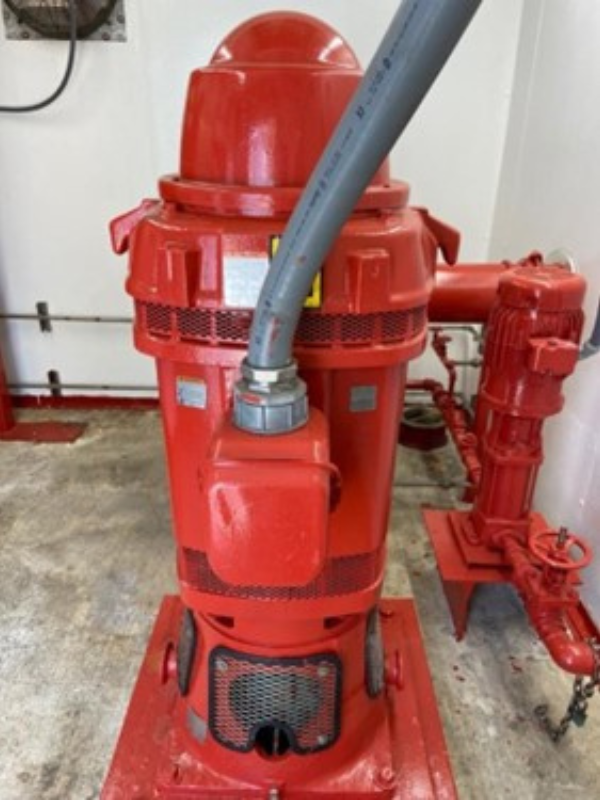
Figure 3: Drafting Fire Pump
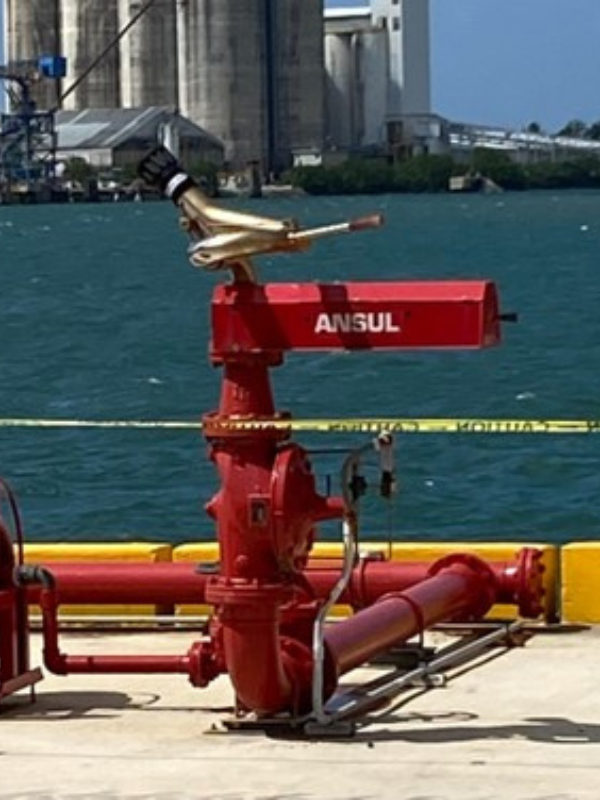
Figure 4: Firewater Monitor
The pumps will be supplying a site wide firewater distribution system. This system will supply any sprinkler systems and fire hydrants, similar to those found in any local community; however, this may also supply monitors, water spray systems, or hydrant manifolds. Water monitors, often referred to as water cannons, are used to spray large quantities of water for use in firefighting. The monitors may be installed in a fixed location to protect a specific piece of equipment, as shown in Figure 4, or they can be trailer mounted and moved based on the specific location of a fire. Additionally, these monitors have adjustable nozzles that can be used to flow a straight stream of water to a target or they can be adjusted to create a large cone of water spray creating a barrier of water to protect anything behind the monitor from radiant heat associated with a large fire.
Additional water supply can be provided by hydrant manifold assemblies as shown in Figure 5, equipped with two (2) Storz connections that can be used to supply a fire truck. On the top of the hydrant there is a monitor, similar to the monitor in Figure 4; however, the monitor on the hydrant manifold is equipped with a self-educting nozzle and a tote of fire-fighting foam that can be used to suppress liquid pool fires.
Although monitors are considered fixed systems, they must be aimed and operated by a fire-fighter. Where automatic cooling or suppression water is warranted a water spray system may be installed. The water spray system consists of open orifice nozzles that are distributed around a piece of protected equipment to provide water for the suppression of a fire or cooling water for exposure protection from radiant heat from a fire at a nearby piece of equipment. The water spray systems typically can be activated by a manual pull station, flame detection, or heat detection.
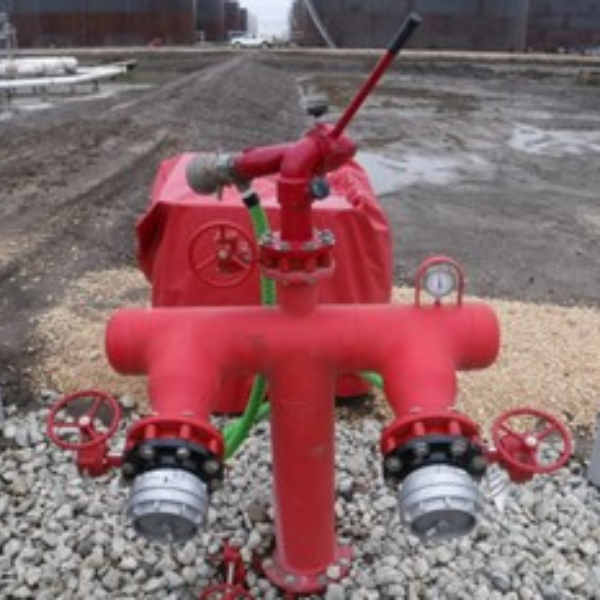
Figure 5: Hydrant Manifold
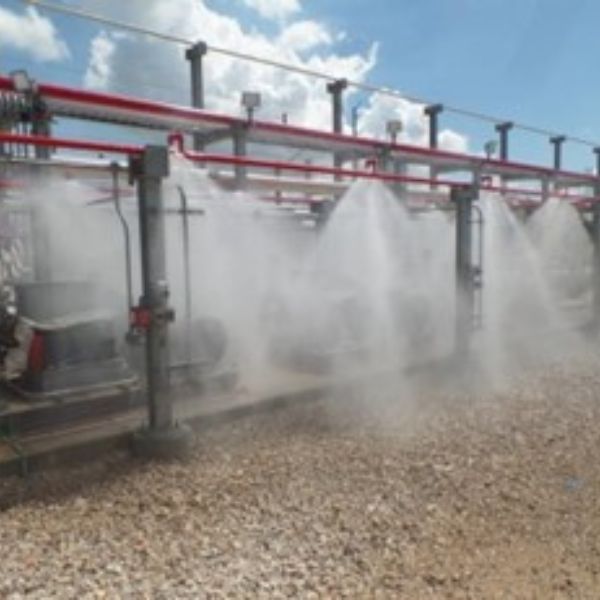
Figure 6: Firewater Spray System
Fire extinguishers are provided throughout the buildings in industrial sites, but they may also be located throughout exterior process areas as well. Typically, handheld fire extinguishers are located near hazardous process equipment. In addition to the handheld fire extinguishers, 1,000-pound extinguishers may be used, shown in Figure 7 below. These are typically located near extremely high hazard equipment handling large volumes of flammable liquids. The 1,000-pound extinguishers include a pressure vessel containing the suppression agent and compressed nitrogen cylinders. Upon activation, the nitrogen cylinders pressurize the vessel, and the dry chemical agent is discharged either through a turret located on the extinguisher skid or through two hoses.
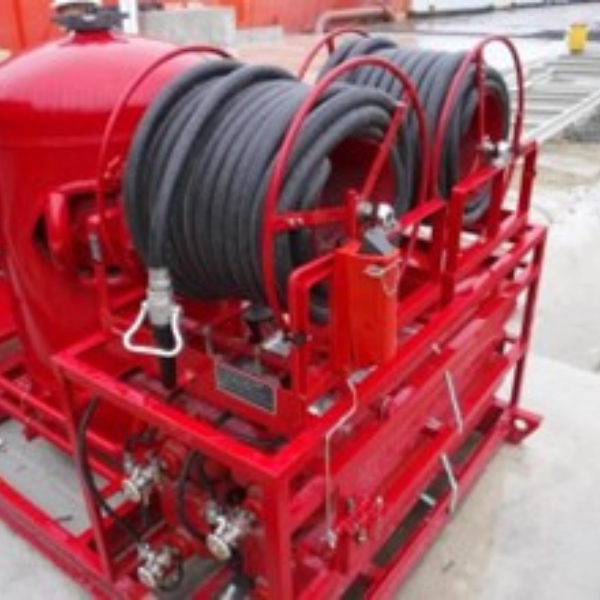
Figure 7: 1,000 Pound Fire Extinguisher
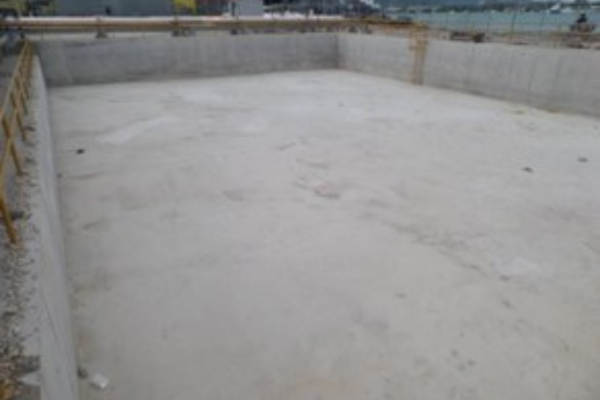
Figure 8: LNG Impoundment Basin
Passive Fire Protection
Passive fire protection in industrial sites can include features such as fire resistive coatings or an impoundment basin designed to collect large-scale product releases. These safety features are very effective in reducing damage during a fire event, as they do not require any moving parts and are very reliable.
During a large-scale fire event structures will be exposed to elevated radiant heat temperatures that can reduce the structural strength of the steel. As such, protective coatings can be added to structural steel to prevent the weakening of structural members. These coatings are typically cementitious or intumescent materials. The cementitious coatings are essentially concrete material that encapsulates a protected structural steel to shield the structure from excess radiant heat. Similarly, intumescent coatings can be applied to protect from radiant heat. The intumescent coatings are thin and expand when exposed to elevated temperatures. As the material expands it provides an insulation to the protected steel to reduce the effect of exposure to radiant heat.
Impoundment basins are essentially large concrete pools, shown in Figure 8, that are designed to collect a flammable liquids release from a large-scale event. Any release would be collected from a tank, drained to a location remote from the tanks, where the flammable products can dissipate into the atmosphere without threat of causing a fire below a storage tank. Although they are a last line in defense behind many active systems, they are useful in reducing severe impacts from a large-scale event.
Summary
It is of critical importance that industrial fire protection systems be designed specifically based on the hazards associated with each specific industrial site. VERTEX employs a dedicated fire protection engineering group with experience in designing industrial fire protection systems around the world. These sites have included distilleries, power plants, LNG storage and processing, flammable liquids storage facilities, petroleum processing plants, and several petrochemical refineries. Many projects have included starting with front-end engineering design (FEED), continuing with detailed design and shop drawings, and lastly final acceptance testing of these installed systems. VERTEX has the capability to model gas releases and base the fire and gas detection systems on likely scenarios to optimize detector quantities and locations. Additionally, VERTEX can complete 3D models using the latest hydraulic software for firewater distribution systems, water spray systems, and fire sprinkler systems, along with full NFPA 13/NFPA 15 hydraulic calculations.
Biography
Brandon Huffman, PE has been a fire protection engineer for over 17 years and is licensed in six states. He has extensive experience in commercial, residential, and industrial fire protection projects throughout the United States, as well as Puerto Rico, Mexico, Nicaragua, Kuwait, Saudi Arabia, and Brunei. Mr. Huffman has experience in utilizing gas release modeling software to locate fire and gas detectors, fire simulations to determine radiant heat effects from likely fire scenarios, completing fire protection engineering drawings, product data submittals, and project specifications. Furthermore, Mr. Huffman has completed final acceptance testing on behalf of the project owner for both the fire and gas detection systems and water distribution systems.
To learn more about VERTEX’s Fire Protection and Engineering Design services or to speak with an Engineering Expert, call 888.298.5162 or submit an inquiry.



